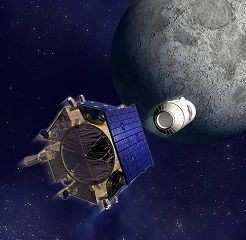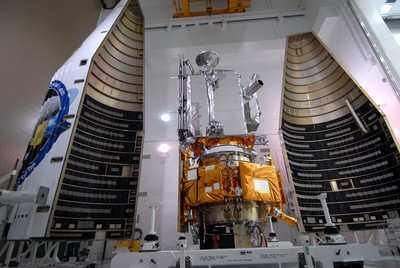Mission Is Designed To Search For Ice On The Moon
 NASA has selected a final
destination for its Lunar Crater Observation and Sensing Satellite,
or LCROSS, after a journey of nearly 5.6 million miles that
included several orbits around Earth and the moon. The mission team
announced Wednesday that Cabeus A will be the target crater for the
LCROSS dual impacts scheduled for 0730 EDT on Ocober 9th. The
crater was selected after an extensive review as the optimal
location for LCROSS' evaluation of whether water ice exists at the
lunar south pole.
NASA has selected a final
destination for its Lunar Crater Observation and Sensing Satellite,
or LCROSS, after a journey of nearly 5.6 million miles that
included several orbits around Earth and the moon. The mission team
announced Wednesday that Cabeus A will be the target crater for the
LCROSS dual impacts scheduled for 0730 EDT on Ocober 9th. The
crater was selected after an extensive review as the optimal
location for LCROSS' evaluation of whether water ice exists at the
lunar south pole.
LCROSS will search for water ice by sending its spent
upper-stage Centaur rocket to impact the permanently shadowed polar
crater. The satellite will fly into the plume of dust left by the
impact and measure the properties before also colliding with the
lunar surface. The LCROSS team selected Cabeus A based on a set of
conditions that include proper debris plume illumination for
visibility from Earth, a high concentration of hydrogen, and mature
crater features such as a flat floor, gentle slopes and the absence
of large boulders.
"The selection of Cabeus A was a result of a vigorous debate
within the lunar science community that included review of the
latest data from Earth-based observatories and our fellow lunar
missions Kaguya, Chandrayaan-1, and the Lunar Reconnaissance
Orbiter," said Anthony Colaprete, LCROSS project scientist and
principle investigator at NASA’s Ames Research Center in
Moffett Field, CA. "The team is looking forward to the impacts and
the wealth of information this unique mission will produce."

LCROSS Artist's Concept
A cadre of professional astronomers using many of the Earth's
most capable observatories is helping maximize the scientific
return from the LCROSS impacts. These observatories include the
Infrared Telescope Facility and Keck telescope in Hawaii; the
Magdalena Ridge and Apache Ridge Observatories in New Mexico and
the MMT Observatory in Arizona; the newly refurbished Hubble Space
Telescope; and the Lunar Reconnaissance Orbiter, among others.
"These and several other telescopes participating in the LCROSS
Observation Campaign will provide observations from different
vantage points using different types of measurement techniques,"
said Jennifer Heldmann, lead for the LCROSS Observation Campaign at
Ames. "These multiple observations will complement the LCROSS
spacecraft data to help determine whether or not water ice exists
in Cabeus A."
During a media briefing Sept. 11, Daniel Andrews, LCROSS project
manager at Ames, provided a mission status update indicating the
spacecraft is healthy and has enough fuel to successfully
accomplish all mission objectives. Andrews also announced the
dedication of the LCROSS mission to the memory of legendary news
anchor, Walter Cronkite, who provided coverage of NASA's missions
from the beginning of America's manned space program to the age of
the space shuttle.

LCROSS NASA Photo
"Dad would sure be proud to be part, if just in name, of getting
humans back up to the moon and beyond," said Chip Cronkite, son of
the famed news anchor.
The LCROSS mission was selected in April 2006 as a mission
manifested with the Lunar Reconnaissance Orbiter. Both missions
launched on June 18, 2009 on an Atlas V from Cape Canaveral, FL.
The LCROSS mission and science operations are managed at Ames.
"The LCROSS team has long been preparing for its final
destination on the moon, and we're looking forward to October 9,"
Andrews said. "The next 28 days will undoubtedly be very
exciting."
 ANN's Daily Aero-Linx (04.13.24)
ANN's Daily Aero-Linx (04.13.24) ANN's Daily Aero-Term (04.13.24): Beyond Visual Line Of Sight (BVLOS)
ANN's Daily Aero-Term (04.13.24): Beyond Visual Line Of Sight (BVLOS) Airborne 04.09.24: SnF24!, Piper-DeltaHawk!, Fisher Update, Junkers
Airborne 04.09.24: SnF24!, Piper-DeltaHawk!, Fisher Update, Junkers Aero-News: Quote of the Day (04.14.24)
Aero-News: Quote of the Day (04.14.24) ANN's Daily Aero-Term (04.14.24): Maximum Authorized Altitude
ANN's Daily Aero-Term (04.14.24): Maximum Authorized Altitude





